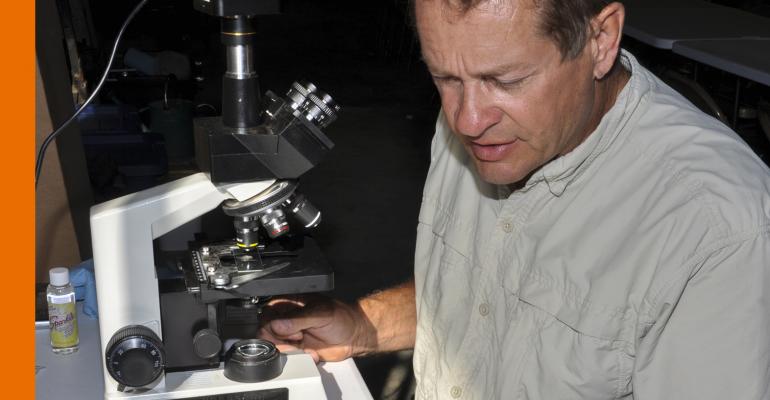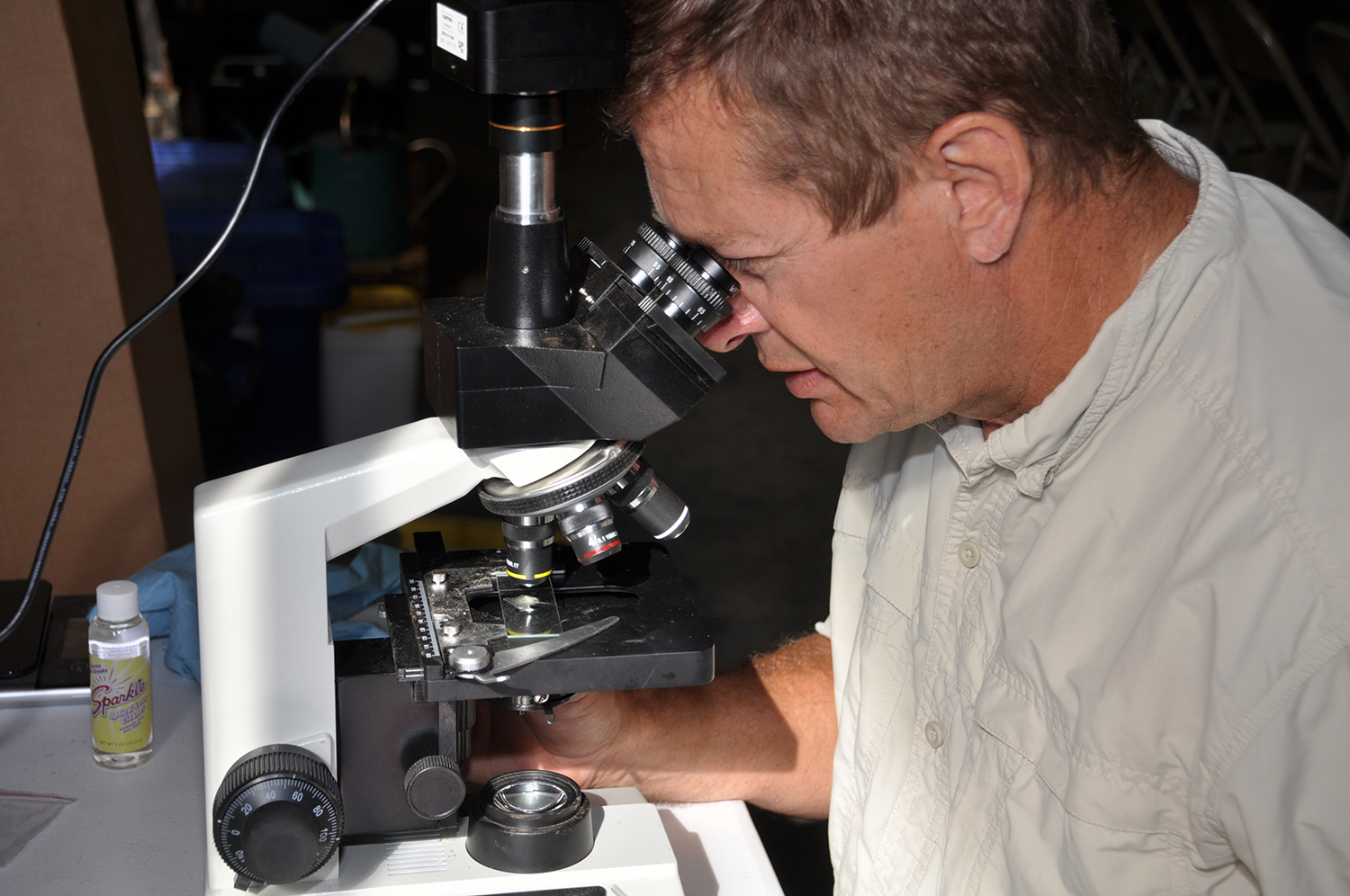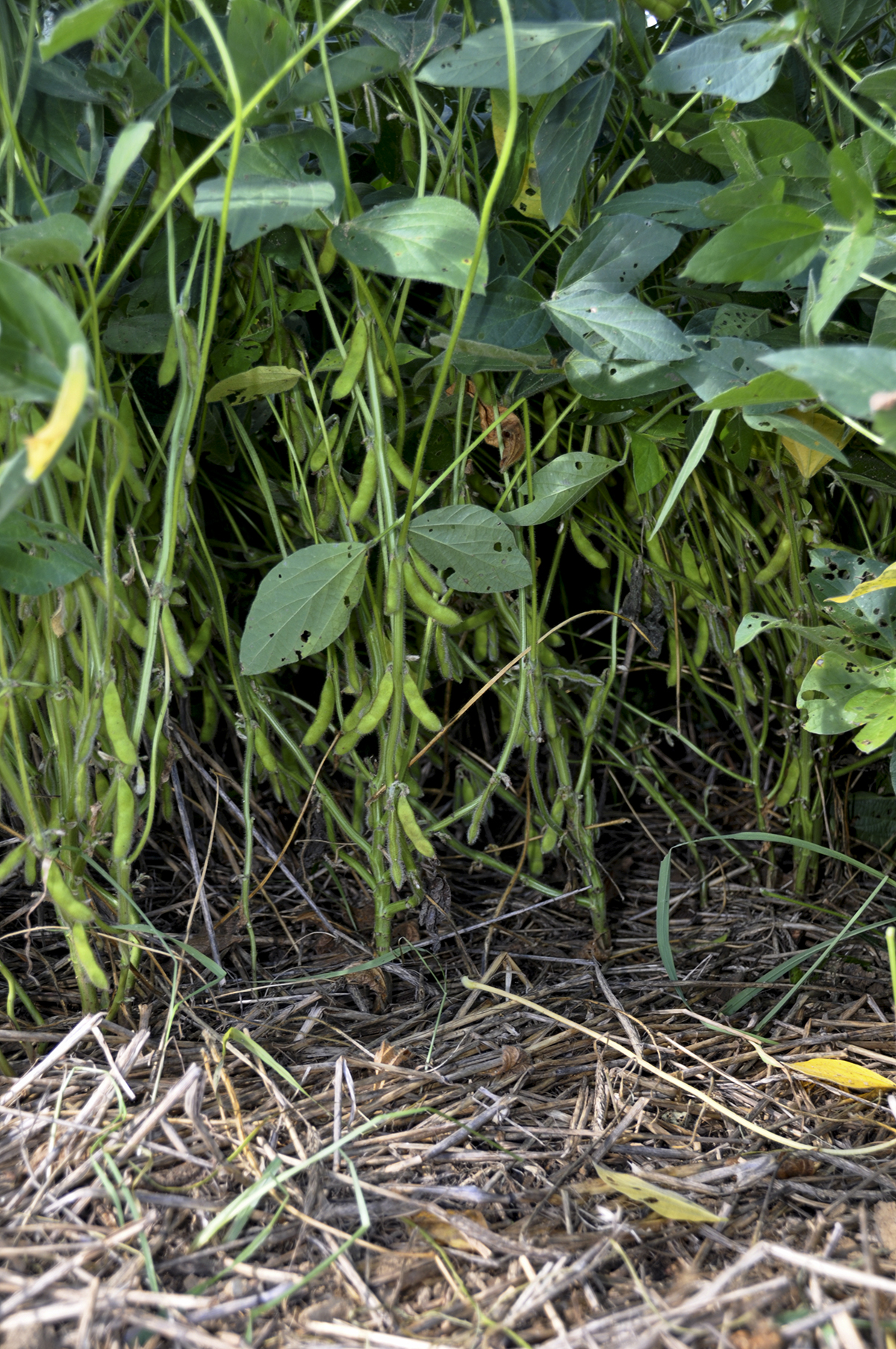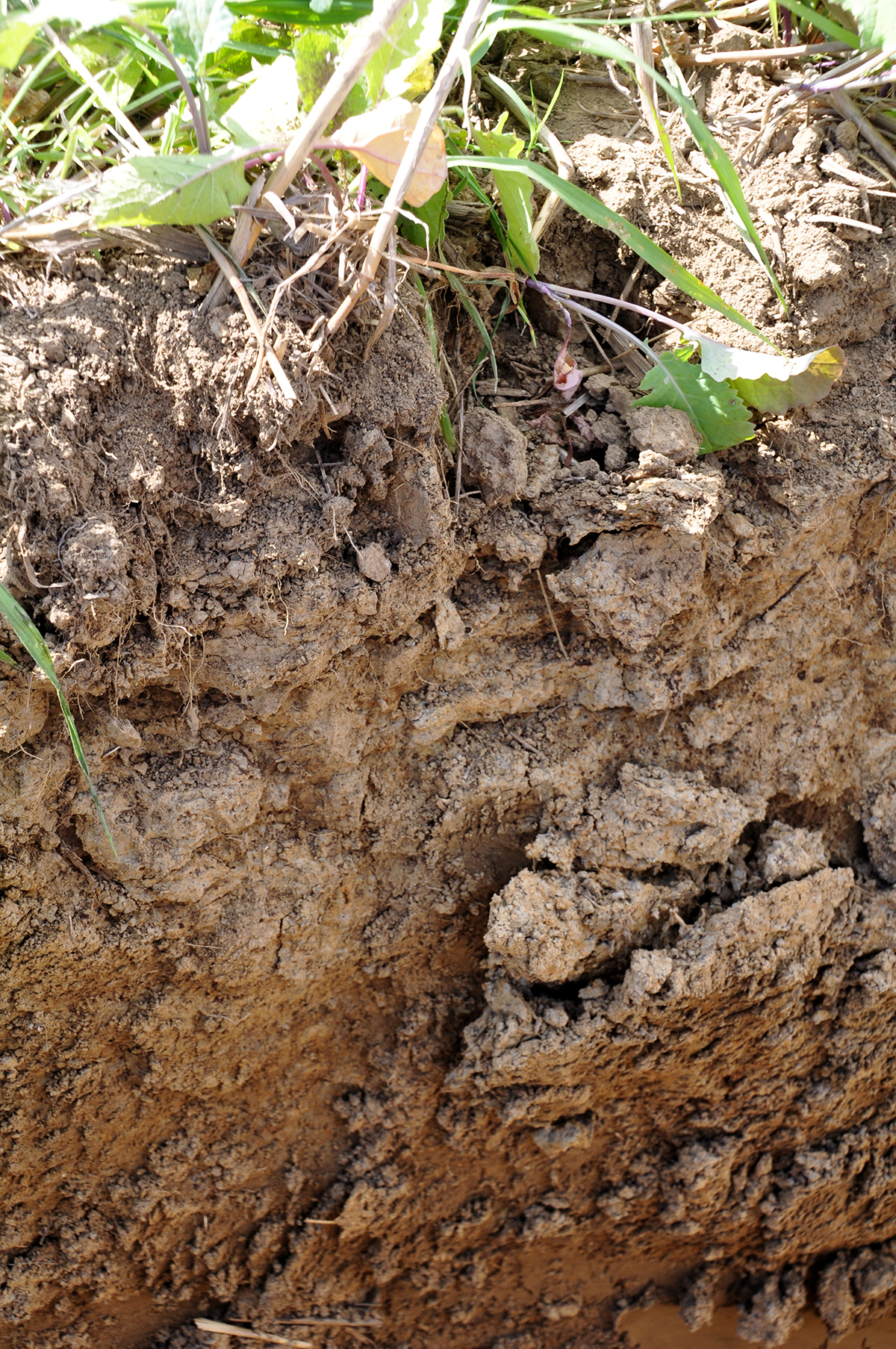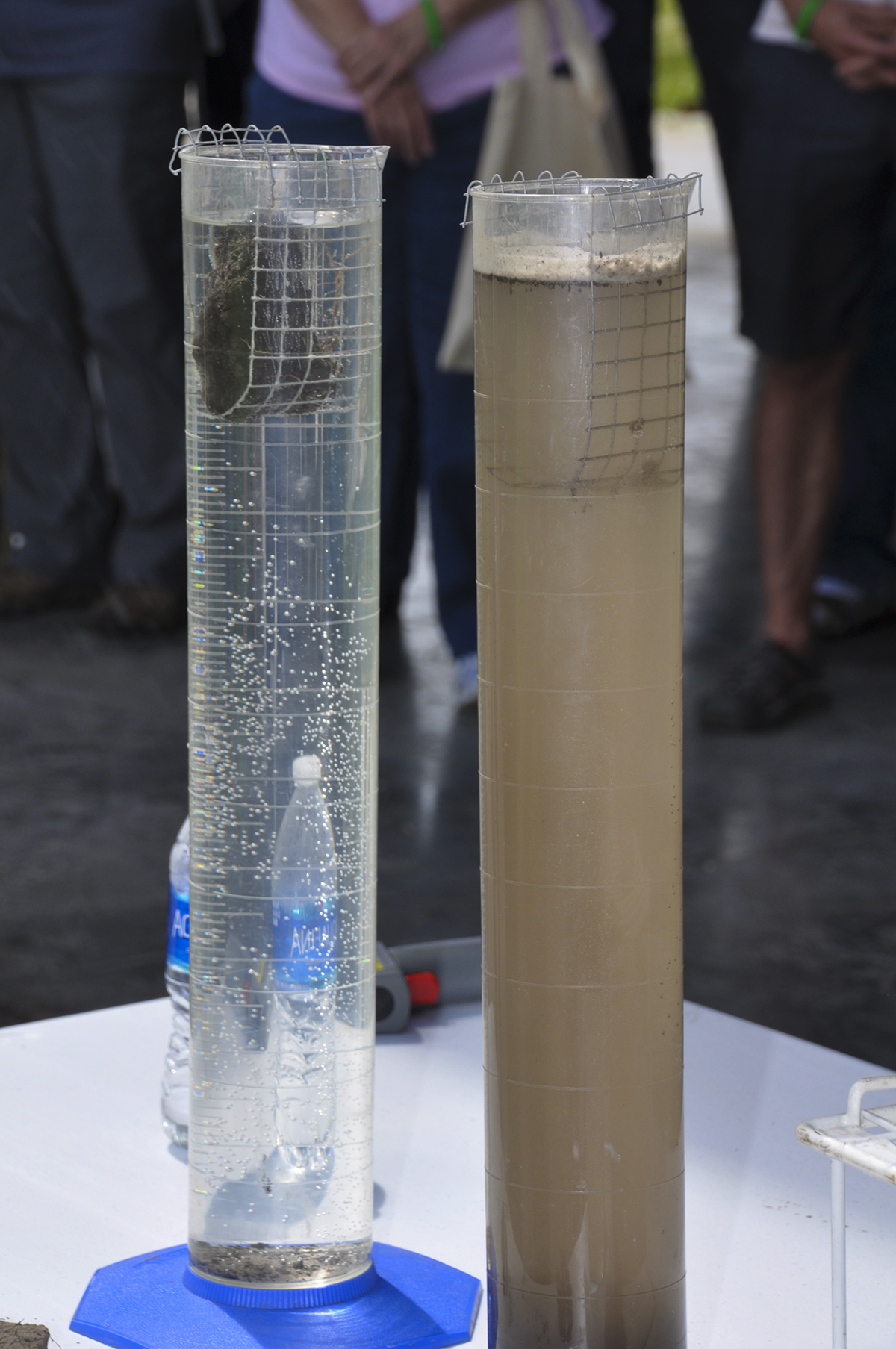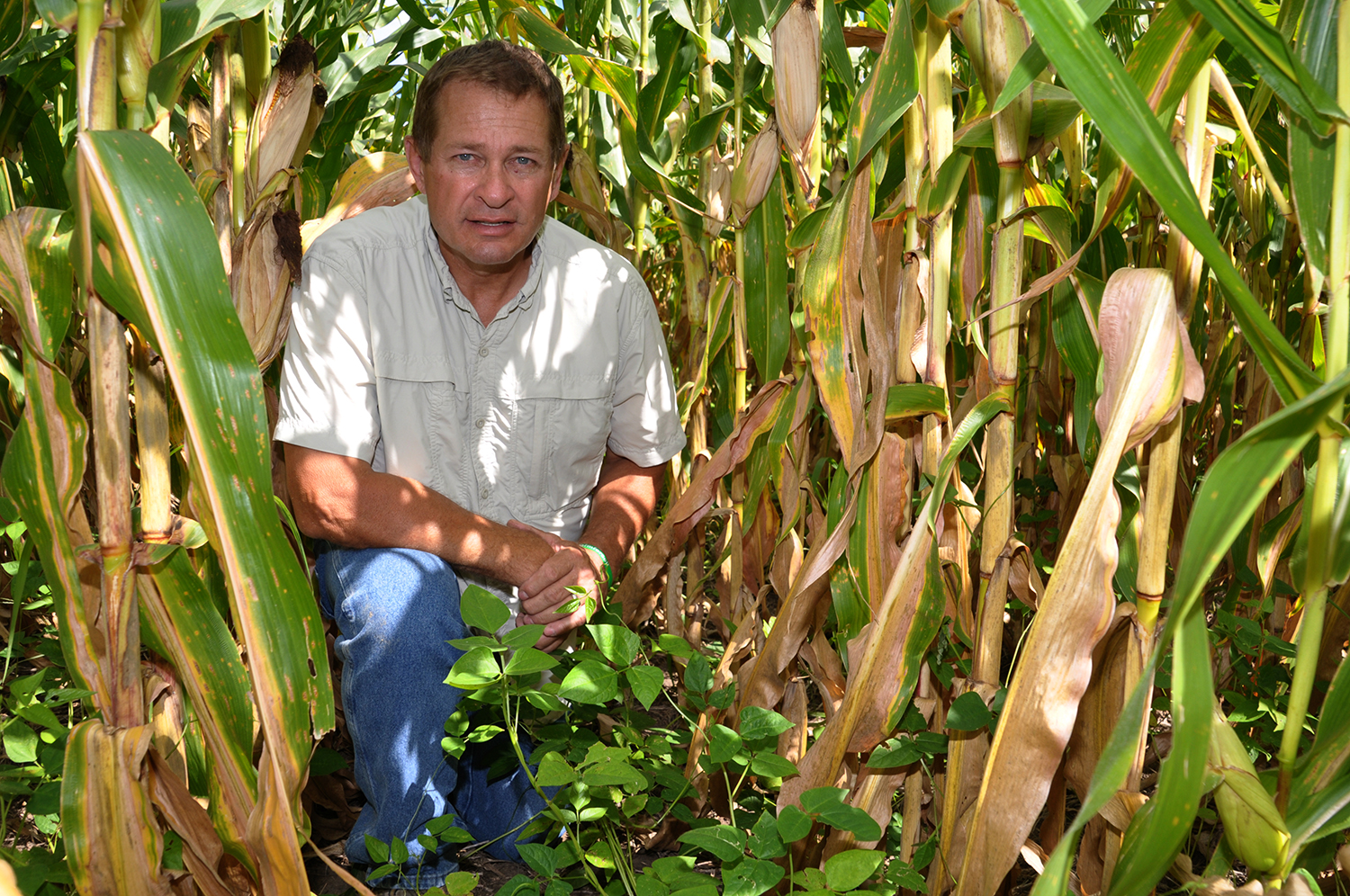Corn and Soybean Digest: Be a soil livestock producer
by Lynn Betts | Nov 06, 2017
Iowa farmer achieves many benefits when cover crops feed and house soil livestock.
Think Different.
Southwest Iowa corn, soybean and “soil livestock” producer Chris Teachout is having fun farming again. With an out-of-the-box mindset, he thinks about capturing free energy from the sun, giving crops access to nutrients across the whole soil profile, and producing those all-important biotic glues in the soil. He’s part of a soil health peer group of farmers and scientists from North Dakota to Ohio to Canada and Europe, and he’s happy to share what he’s learning.
You know you’re not dealing with just any farmer when the first thing you spot in the front of his farm shop is a microscope. And not every farmer will dig multiple soil pits in corn and soybean fields to study root paths of both cover crops and row crops, and show them to anyone who wants to look and learn.
You’ll also look awhile to find someone with seven cover crop trials interseeded into corn – testing such legumes as mung beans, pigeon peas, and sunn hemp, along with cool season turnips, rape, cabbage and collards, and more. And not many farmers fly to Ireland to see what leading farmers there are doing to boost soil health?
Iowan Chris Teachout is such a farmer. “I found out the soil health movement is worldwide,” says Teachout, who farms 1400 acres near Shenandoah with his wife Janenne. “We’re all trying to understand soil biology—it’s the key to water efficiency, infiltration, and holding on to nutrients. The biotic glues that hold the soil together and form soil aggregates make all the difference in soil health, water quality, and sustainable cropping systems.”
Fun examining soil livestock
“We can see what’s going on above ground, but it’s a lot harder to understand what’s happening below ground,” Teachout says. He got his microscope after discussions with Dr. Jill Clapperton, a rhizosphere ecologist and international soil health expert. “She’s teaching me how to look for the livestock in the soil myself. It’s quicker; I can still confirm what I see with lab testing.”
Teachout looks through the scope for things like micorrhizal fungi, and for both numbers and variety of soil critters like arthropods, bacteria and protozoa in the soil. On his trials, he’s looking to see if there’s a balance, or an explosion of one kind or another. Looking at his soil livestock takes him back to the days years ago when he had livestock and crop rotations. “I had fun in those days, with hay in the rotation and a diversity of crops,” he says. “But like many other farmers, we moved to a corn-soybean system. Now with cover crops and annual pollinator strips I’m getting that diversity back and having fun again,” he adds.
Doubled organic matter levels
“A lot of the livestock in the soil is in dormancy,” Teachout says. “You can bring it out of that in a very short while—I’ve seen that on my farm.” He said organic matter levels on the farm in the 1980’s when he was tilling the soil were from 2.4 to 2.7%. “We started no-tilling about 20 years ago, and gradually lifted organic matter to 3.4%. It pretty much stabilized. Then we started using cover crops 5 years ago—in that time, we’ve raised organic matter levels to as much as 5.4%.”
Aha moment with cereal rye
Growing cereal rye, Teachout’s mainstay cover crop, isn’t a new thing for him. “In the mid-80s dad had farrow-to-finish hogs. We grew our own cereal rye for seed, sold some, and used the straw for bedding for the hogs,” Teachout recalls. “We did some early spring mob-grazing with our cow-calf herd, too—we could get 40 days of grazing for 80 cow-calf pairs on 20 acres of rye. But, in the 90s it was easy to bale up cornstalks as bedding and for sale, so we quit growing cereal rye. Now I know we were exporting carbon from our soil.”
Teachout remembers disking up the rye in 1984 (he didn’t no-till then) and planting soybeans. “They made 54 bushels to the acre one year, when the best our other beans did was 48 bushels an acre. When I went to a meeting on cover crops 5 years ago, the light bulb went off and I remembered how all that worked. I jumped on board,” he says.
Improved weed control, soil temperatures
Most of Teachout’s land is cover-cropped. He’s continually testing and analyzing results from field to field. “Cereal rye has really shown it can help with weed control,” Teachout says. “I’m trying to maximize that by planting into very tall rye. I’ve done some rolling at planting and that leaves a really good armor on the soil—it’s like a mattress, pushing down when machinery goes over it but then bouncing back. You get much better armor with that mat than just no-till,” he says.
Curious about soil temperatures with and without the armor of a rye cover crop, Teachout got his soil thermometer out last year after a week of hot weather. “The surface temperature of the soil in the no-till field where most of the crop residues had vanished was 148 degrees, like an asphalt sidewalk,” Teachout says. “Microbial activity had long since stopped in those temperatures—I think activity stops at about 90 degrees. Under the mat of flattened rye straw, the surface temperature was in the upper 80s. That’s significant, because you want that soil biology working all the time,” he says, “and that cover keeps the plant roots cool, to keep water and nutrients moving up into the plant.”
Soil binding glues
Teachout has used the slake test to compare soil structure on long-term no-till soils with no-till soils with cover crops growing for 5 years. “There’s a big-time difference in how the two hold up in water. The cornstalks don’t break down as fast in no-till only, and the glues that hold the soil together aren’t there like they are with cover crops,” he says. He also saw water runoff after a 3.5” rain in 2017 in a no-till field that looked like chocolate milk. “But what water did run off in cover crop fields was clear. I’d guess only a third as much water ran off from the cover crop field. I don’t want to see water coming down the grassed waterways after a heavy rain—I want it into the ground,” Teachout says.
Healthy soil builds roots
Most corn and soybean roots angle down in the soil in a triangular pattern, Teachout notes. “But in 30” rows, that means those roots aren’t accessing nutrients across the top of the profile,” Teachout says. “The roots grow down to access nutrients and moisture—how do we get roots to grow laterally? In healthy soils with good structure, the roots grow towards the middle of the row and deep into the profile.”
That’s what Teachout sees in soil pits he digs to examine root patterns. He’s seen soybean nodules just an inch deep in the middle of the row, and rye roots to the bottom of a 4-ft. pit with earthworm tunnels more than 2 feet down into the profile. “You’ll have fungi and bacteria on all those rye roots, no matter how deep they go into the soil,” Clapperton tells Teachout. “They’ll move up, down and sideways with the roots. Bacteria and fungi go into hibernation, but they work down to about 29 degrees farenheit, and those deeper in the soil stay active longer. You might not think about it, but earthworms are also taking carbon down deeper into the profile.”
Teachout knows his rye roots are sequestering nitrogen. “I’ve dug rye roots up in January after soybeans, and the rye roots are piercing soybean nodules. So I know they’re grabbing nitrogen,” he says.
Hold water and nutrients
“Soil aggregates and good soil structure come from the life in the soil,” Clapperton told a group of more than 100 farmers attending a Practical Farmers of Iowa field day at Teachout’s farm in late August. “It all comes down to what’s living in the soil. You can’t move water and you can’t hold water without aggregate stability. With a lot of life in the soil, you can drain water in a wet year and hold water in a dry year.”
“A healthy soil doesn’t leak nutrients,” Clapperton says. “Our goal is a non-leaky, closed system that reduces inputs, supplementing biological with chemical fertility.” Teachout says he’s not trying to get completely away from commercial fertilizer, but he does want to reduce inputs. “The Haney test tells me I don’t need P and K,” he says. “It indicates soil health—my bottom number on it is 17.6, compares to 4 to 7 on more traditional fields. So there’s a lot more life in the soil.”
Where to start
Teachout says he’s been through the basics, and made the mistakes a first-time cover cropper might make. “We’ll help you avoid the mistakes we’ve made,” he says of his peer group of pioneers. Pointers he has for first time users include:
- Cereal rye after corn, going into soybeans, should offer the most trouble-free first experience.
- Try some test strips to compare results of any variables you are concerned or curious about.
- Find a farmer experienced in cover crops to coach you through trouble spots.
- Use your spade, and observe what’s happening with your soil.
- If there’s something you don’t understand, use social media to get opinions.
- Don’t be afraid to ask—there are no dumb questions.
Interseeding experiments
Teachout uses rye primarily, but has experimented with a number of other cover crops. He’s tried spring oats, spring barley, mustard, radish, and peas. He planted a 70/30 oats and barley combination this fall after the combine on some of the land, with some rye in the mix on some fields for a spring greenup.
“I’d like to keep moving towards multiple species,” he says. This past year, he experimented with a number of out of the ordinary possibilities in interseeded test plots. “I wanted to find out which of the legumes I was interested in would survive, and how much nitrogen they could add to the corn,” Teachout says.
His picks weren’t your usual clovers. Instead, he tested guar, mung beans, fava beans, iron and clay cowpeas, zippercream cowpeas, pigeon peas, and sunn hemp. Each of the legumes was interseeded into one row of corn with a combination of cool season turnip, rape, nitro radish, mustard, radish, cabbage and collards.
He interplanted the covers into corn at the v4 to v5 stage with only 50 pounds of nitrogen applied.
“The cool season plants were shaded out by the corn and didn’t survive,” Teachout says. “But I did learn that sunn hemp likes cowpeas. The pigeon peas did really well in the corn—they have an extreme taproot. I also learned that deer love sunn hemp, and that it grows back after grazing. That’s helpful information for livestock producers,” he says.
Teachout planned to compare corn yields, and also measure the amount of N in stalks and analyze the grain for nutrient density. There could be premiums offered for nutrient-dense corn in the future, he reasons, so he’s keeping performance records to guide future tests.
